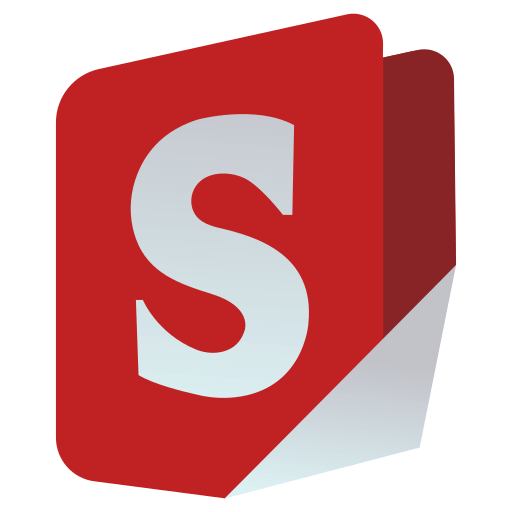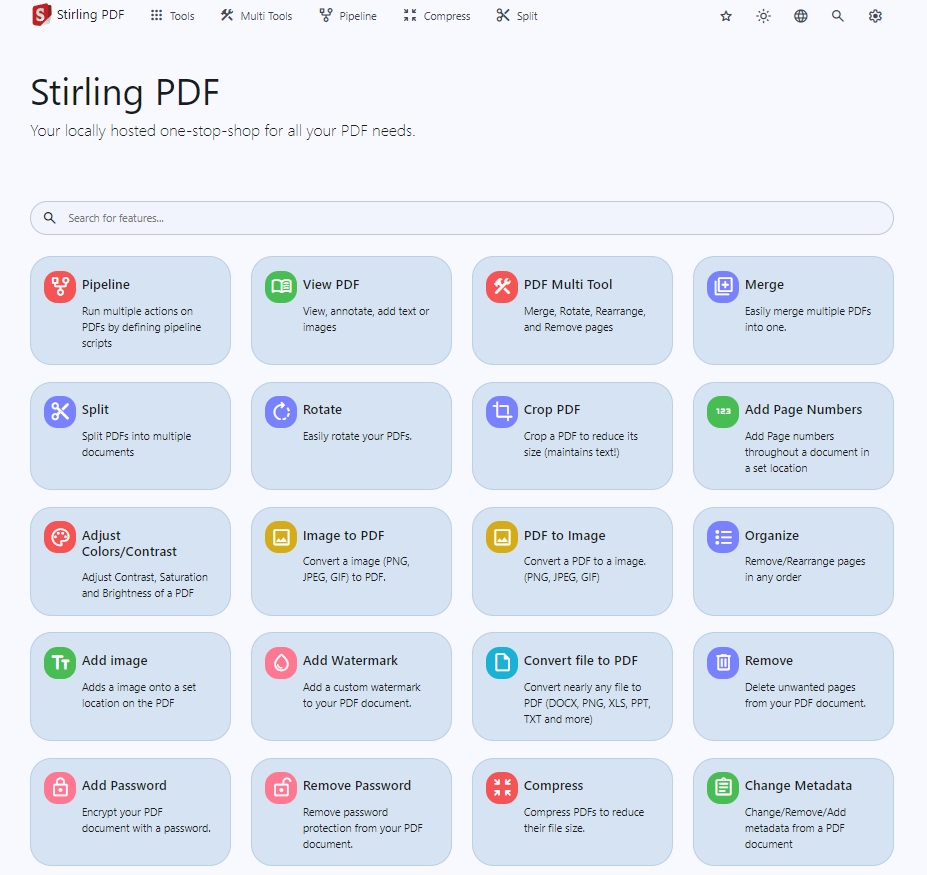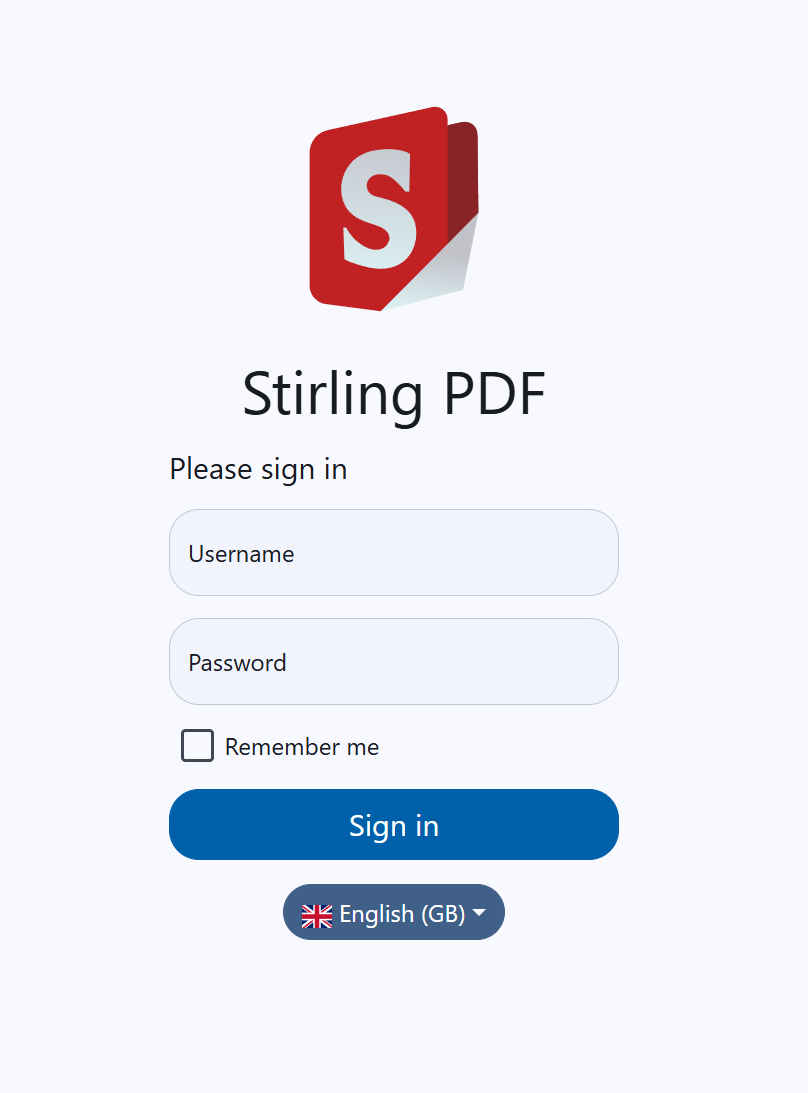|
|
||
|---|---|---|
| .github | ||
| .vscode | ||
| cucumber | ||
| docs | ||
| exampleYmlFiles | ||
| gradle/wrapper | ||
| images | ||
| pipeline/defaultWebUIConfigs | ||
| scripts | ||
| src | ||
| .git-blame-ignore-revs | ||
| .gitattributes | ||
| .gitignore | ||
| .pre-commit-config.yaml | ||
| build.gradle | ||
| CONTRIBUTING.md | ||
| DATABASE.md | ||
| DeveloperGuide.md | ||
| Dockerfile | ||
| Dockerfile-fat | ||
| Dockerfile-ultra-lite | ||
| Endpoint-groups.md | ||
| FolderScanning.md | ||
| gradlew | ||
| gradlew.bat | ||
| HowToAddNewLanguage.md | ||
| HowToUseOCR.md | ||
| lauch4jConfig.xml | ||
| LICENSE | ||
| LocalRunGuide.md | ||
| PipelineFeature.md | ||
| README.md | ||
| SECURITY.md | ||
| settings.gradle | ||
| test2.sh | ||
| test.sh | ||
| Version-groups.md | ||

Stirling-PDF
Stirling-PDF is a robust, locally hosted web-based PDF manipulation tool using Docker. It enables you to carry out various operations on PDF files, including splitting, merging, converting, reorganizing, adding images, rotating, compressing, and more. This locally hosted web application has evolved to encompass a comprehensive set of features, addressing all your PDF requirements.
All files and PDFs exist either exclusively on the client side, reside in server memory only during task execution, or temporarily reside in a file solely for the execution of the task. Any file downloaded by the user will have been deleted from the server by that point.
Features
- Enterprise features like SSO Check here
- Dark mode support
- Custom download options
- Parallel file processing and downloads
- Custom 'Pipelines' to run multiple features in a queue
- API for integration with external scripts
- Optional Login and Authentication support (see here for documentation)
- Database Backup and Import (see here for documentation)
PDF Features
Page Operations
- View and modify PDFs - View multi-page PDFs with custom viewing, sorting, and searching. Plus, on-page edit features like annotating, drawing, and adding text and images. (Using PDF.js with Joxit and Liberation fonts)
- Full interactive GUI for merging/splitting/rotating/moving PDFs and their pages
- Merge multiple PDFs into a single resultant file
- Split PDFs into multiple files at specified page numbers or extract all pages as individual files
- Reorganize PDF pages into different orders
- Rotate PDFs in 90-degree increments
- Remove pages
- Multi-page layout (format PDFs into a multi-paged page)
- Scale page contents size by set percentage
- Adjust contrast
- Crop PDF
- Auto-split PDF (with physically scanned page dividers)
- Extract page(s)
- Convert PDF to a single page
- Overlay PDFs on top of each other
- PDF to a single page
- Split PDF by sections
Conversion Operations
- Convert PDFs to and from images
- Convert any common file to PDF (using LibreOffice)
- Convert PDF to Word/PowerPoint/others (using LibreOffice)
- Convert HTML to PDF
- Convert PDF to XML
- Convert PDF to CSV
- URL to PDF
- Markdown to PDF
Security & Permissions
- Add and remove passwords
- Change/set PDF permissions
- Add watermark(s)
- Certify/sign PDFs
- Sanitize PDFs
- Auto-redact text
Other Operations
- Add/generate/write signatures
- Split by Size or PDF
- Repair PDFs
- Detect and remove blank pages
- Compare two PDFs and show differences in text
- Add images to PDFs
- Compress PDFs to decrease their filesize (using qpdf)
- Extract images from PDF
- Remove images from PDF
- Extract images from scans
- Remove annotations
- Add page numbers
- Auto-rename files by detecting PDF header text
- OCR on PDF (using Tesseract OCR)
- PDF/A conversion (using LibreOffice)
- Edit metadata
- Flatten PDFs
- Get all information on a PDF to view or export as JSON
- Show/detect embedded JavaScript
For an overview of the tasks and the technology each uses, please view Endpoint-groups.md.
A demo of the app is available here.
Technologies Used
- Spring Boot + Thymeleaf
- PDFBox
- LibreOffice for advanced conversions
- qpdf
- HTML, CSS, JavaScript
- Docker
- PDF.js
- PDF-LIB.js
How to Use
Windows
For Windows users, download the latest Stirling-PDF.exe from our release section or by clicking here.
Locally
Please view the LocalRunGuide.
Docker / Podman
Note
Stirling-PDF has three different versions: a full version, an ultra-lite version, and a 'fat' version. Depending on the types of features you use, you may want a smaller image to save on space. To see what the different versions offer, please look at our version mapping. For people who don't mind space optimization, just use the latest tag.
Please note in the examples below, you may need to change the volume paths as needed, e.g., ./extraConfigs:/configs to /opt/stirlingpdf/extraConfigs:/configs.
Docker Run
docker run -d \
-p 8080:8080 \
-v ./trainingData:/usr/share/tessdata \
-v ./extraConfigs:/configs \
-v ./logs:/logs \
# Optional customization (not required)
# -v /location/of/customFiles:/customFiles \
-e DOCKER_ENABLE_SECURITY=false \
-e INSTALL_BOOK_AND_ADVANCED_HTML_OPS=false \
-e LANGS=en_GB \
--name stirling-pdf \
stirlingtools/stirling-pdf:latest
Docker Compose
version: '3.3'
services:
stirling-pdf:
image: stirlingtools/stirling-pdf:latest
ports:
- '8080:8080'
volumes:
- ./trainingData:/usr/share/tessdata # Required for extra OCR languages
- ./extraConfigs:/configs
# - ./customFiles:/customFiles/
# - ./logs:/logs/
environment:
- DOCKER_ENABLE_SECURITY=false
- INSTALL_BOOK_AND_ADVANCED_HTML_OPS=false
- LANGS=en_GB
Note: Podman is CLI-compatible with Docker, so simply replace "docker" with "podman".
Kubernetes
See the kubernetes helm chart here
Enable OCR/Compression Feature
Please view the HowToUseOCR.md.
Reuse Stored Files
Certain functionality like Sign supports pre-saved files stored at /customFiles/signatures/. Image files placed here will be accessible via the web UI. Currently, this supports two folder types:
/customFiles/signatures/ALL_USERS: Accessible to all users, useful for organizations where many users use the same files or for users not using authentication/customFiles/signatures/{username}: Such as/customFiles/signatures/froodle, accessible only to thefroodleusername, private for all others
Supported Languages
Stirling-PDF currently supports 38 languages!
Contributing (Creating Issues, Translations, Fixing Bugs, etc.)
Please see our Contributing Guide.
Stirling PDF Enterprise
Stirling PDF offers an Enterprise edition of its software. This is the same great software but with added features and comforts.
What's included
- Prioritized Support tickets via support@stirlingpdf.com to reach directly to Stirling-PDF team for support and 1:1 meetings where applicable (Provided they come from the same email domain registered with us)
- Prioritised Enhancements to Stirling-PDF where applicable
- Base SSO support
- Advanced SSO such as automated login handling (Coming very soon)
- SAML SSO (Coming very soon)
- Custom automated metadata handling
- Advanced user configurations (Coming soon)
- Plus other exciting features to come
Check out our docs on it or our official website
Customization
Stirling-PDF allows easy customization of the app, including things like:
- Custom application name
- Custom slogans, icons, HTML, images, CSS, etc. (via file overrides)
There are two options for this, either using the generated settings file settings.yml, which is located in the /configs directory and follows standard YAML formatting, or using environment variables, which would override the settings file.
For example, in settings.yml, you might have:
security:
enableLogin: 'true'
To have this via an environment variable, you would use SECURITY_ENABLELOGIN.
The current list of settings is:
security:
enableLogin: false # set to 'true' to enable login
csrfDisabled: true # set to 'true' to disable CSRF protection (not recommended for production)
loginAttemptCount: 5 # lock user account after 5 tries; when using e.g. Fail2Ban you can deactivate the function with -1
loginResetTimeMinutes: 120 # lock account for 2 hours after x attempts
loginMethod: all # 'all' (Login Username/Password and OAuth2[must be enabled and configured]), 'normal'(only Login with Username/Password) or 'oauth2'(only Login with OAuth2)
initialLogin:
username: '' # initial username for the first login
password: '' # initial password for the first login
oauth2:
enabled: false # set to 'true' to enable login (Note: enableLogin must also be 'true' for this to work)
client:
keycloak:
issuer: '' # URL of the Keycloak realm's OpenID Connect Discovery endpoint
clientId: '' # client ID for Keycloak OAuth2
clientSecret: '' # client secret for Keycloak OAuth2
scopes: openid, profile, email # scopes for Keycloak OAuth2
useAsUsername: preferred_username # field to use as the username for Keycloak OAuth2
google:
clientId: '' # client ID for Google OAuth2
clientSecret: '' # client secret for Google OAuth2
scopes: https://www.googleapis.com/auth/userinfo.email, https://www.googleapis.com/auth/userinfo.profile # scopes for Google OAuth2
useAsUsername: email # field to use as the username for Google OAuth2
github:
clientId: '' # client ID for GitHub OAuth2
clientSecret: '' # client secret for GitHub OAuth2
scopes: read:user # scope for GitHub OAuth2
useAsUsername: login # field to use as the username for GitHub OAuth2
issuer: '' # set to any provider that supports OpenID Connect Discovery (/.well-known/openid-configuration) endpoint
clientId: '' # client ID from your provider
clientSecret: '' # client secret from your provider
autoCreateUser: false # set to 'true' to allow auto-creation of non-existing users
blockRegistration: false # set to 'true' to deny login with SSO without prior registration by an admin
useAsUsername: email # default is 'email'; custom fields can be used as the username
scopes: openid, profile, email # specify the scopes for which the application will request permissions
provider: google # set this to your OAuth provider's name, e.g., 'google' or 'keycloak'
saml2:
enabled: false # currently in alpha, not recommended for use yet, enableAlphaFunctionality must be set to true
autoCreateUser: false # set to 'true' to allow auto-creation of non-existing users
blockRegistration: false # set to 'true' to deny login with SSO without prior registration by an admin
registrationId: stirling
idpMetadataUri: https://dev-XXXXXXXX.okta.com/app/externalKey/sso/saml/metadata
idpSingleLogoutUrl: https://dev-XXXXXXXX.okta.com/app/dev-XXXXXXXX_stirlingpdf_1/externalKey/slo/saml
idpSingleLoginUrl: https://dev-XXXXXXXX.okta.com/app/dev-XXXXXXXX_stirlingpdf_1/externalKey/sso/saml
idpIssuer: http://www.okta.com/externalKey
idpCert: classpath:okta.crt
privateKey: classpath:saml-private-key.key
spCert: classpath:saml-public-cert.crt
enterpriseEdition:
enabled: false # set to 'true' to enable enterprise edition
key: 00000000-0000-0000-0000-000000000000
CustomMetadata:
autoUpdateMetadata: false # set to 'true' to automatically update metadata with below values
author: username # supports text such as 'John Doe' or types such as username to autopopulate with user's username
creator: Stirling-PDF # supports text such as 'Company-PDF'
producer: Stirling-PDF # supports text such as 'Company-PDF'
legal:
termsAndConditions: https://www.stirlingpdf.com/terms-and-conditions # URL to the terms and conditions of your application (e.g. https://example.com/terms). Empty string to disable or filename to load from local file in static folder
privacyPolicy: https://www.stirlingpdf.com/privacy-policy # URL to the privacy policy of your application (e.g. https://example.com/privacy). Empty string to disable or filename to load from local file in static folder
accessibilityStatement: '' # URL to the accessibility statement of your application (e.g. https://example.com/accessibility). Empty string to disable or filename to load from local file in static folder
cookiePolicy: '' # URL to the cookie policy of your application (e.g. https://example.com/cookie). Empty string to disable or filename to load from local file in static folder
impressum: '' # URL to the impressum of your application (e.g. https://example.com/impressum). Empty string to disable or filename to load from local file in static folder
system:
defaultLocale: en-US # set the default language (e.g. 'de-DE', 'fr-FR', etc)
googlevisibility: false # 'true' to allow Google visibility (via robots.txt), 'false' to disallow
enableAlphaFunctionality: false # set to enable functionality which might need more testing before it fully goes live (this feature might make no changes)
showUpdate: false # see when a new update is available
showUpdateOnlyAdmin: false # only admins can see when a new update is available, depending on showUpdate it must be set to 'true'
customHTMLFiles: false # enable to have files placed in /customFiles/templates override the existing template HTML files
tessdataDir: /usr/share/tessdata # path to the directory containing the Tessdata files. This setting is relevant for Windows systems. For Windows users, this path should be adjusted to point to the appropriate directory where the Tessdata files are stored.
enableAnalytics: undefined # set to 'true' to enable analytics, set to 'false' to disable analytics; for enterprise users, this is set to true
ui:
appName: '' # application's visible name
homeDescription: '' # short description or tagline shown on the homepage
appNameNavbar: '' # name displayed on the navigation bar
endpoints:
toRemove: [] # list endpoints to disable (e.g. ['img-to-pdf', 'remove-pages'])
groupsToRemove: [] # list groups to disable (e.g. ['LibreOffice'])
metrics:
enabled: true # 'true' to enable Info APIs (`/api/*`) endpoints, 'false' to disable
# Automatically Generated Settings (Do Not Edit Directly)
AutomaticallyGenerated:
key: example
UUID: example
There is an additional config file /configs/custom_settings.yml where users familiar with Java and Spring application.properties can input their own settings on top of Stirling-PDF's existing ones.
Extra Notes
- Endpoints: Currently, the
ENDPOINTS_TO_REMOVEandGROUPS_TO_REMOVEendpoints can include comma-separated lists of endpoints and groups to disable. For example,ENDPOINTS_TO_REMOVE=img-to-pdf,remove-pageswould disable both image-to-pdf and remove pages, whileGROUPS_TO_REMOVE=LibreOfficewould disable all things that use LibreOffice. You can see a list of all endpoints and groups here. - customStaticFilePath: Customize static files such as the app logo by placing files in the
/customFiles/static/directory. An example of customizing the app logo is placing/customFiles/static/favicon.svgto override the current SVG. This can be used to change anyimages/icons/css/fonts/js, etc. in Stirling-PDF.
Environment-Only Parameters
SYSTEM_ROOTURIPATH- Set the application's root URI (e.g./pdf-appto set the root URI tolocalhost:8080/pdf-app)SYSTEM_CONNECTIONTIMEOUTMINUTES- Set custom connection timeout valuesDOCKER_ENABLE_SECURITY- Set totrueto download security jar (required for authentication login)INSTALL_BOOK_AND_ADVANCED_HTML_OPS- Download Calibre onto Stirling-PDF to enable PDF to/from book and advanced HTML conversionLANGS- Define custom font libraries to install for document conversions
API
For those wanting to use Stirling-PDF's backend API to link with their own custom scripting to edit PDFs, you can view all existing API documentation here, or navigate to /swagger-ui/index.html of your Stirling-PDF instance for your version's documentation (or by following the API button in the settings of Stirling-PDF).
Login Authentication
Prerequisites
- User must have the folder
./configsvolumed within Docker so that it is retained during updates. - Docker users must download the security jar version by setting
DOCKER_ENABLE_SECURITYtotruein environment variables. - Then either enable login via the
settings.ymlfile or setSECURITY_ENABLE_LOGINtotrue. - Now the initial user will be generated with username
adminand passwordstirling. On login, you will be forced to change the password to a new one. You can also use the environment variablesSECURITY_INITIALLOGIN_USERNAMEandSECURITY_INITIALLOGIN_PASSWORDto set your own credentials straight away (recommended to remove them after user creation).
Once the above has been done, on restart, a new stirling-pdf-DB.mv.db will show if everything worked.
When you log in to Stirling-PDF, you will be redirected to the /login page to log in with those default credentials. After login, everything should function as normal.
To access your account settings, go to Account Settings in the settings cog menu (top right in the navbar). This Account Settings menu is also where you find your API key.
To add new users, go to the bottom of Account Settings and hit 'Admin Settings'. Here, you can add new users. The different roles mentioned within this are for rate limiting. This is a work in progress and will be expanded on more in the future.
For API usage, you must provide a header with X-API-KEY and the associated API key for that user.
FAQ
Q1: What are your planned features?
- Progress bar/tracking
- Full custom logic pipelines to combine multiple operations together
- Folder support with auto-scanning to perform operations on
- Redact text (via UI, not just automated)
- Add forms
- Multi-page layout (stitch PDF pages together) support x rows y columns and custom page sizing
- Fill forms manually or automatically
Q2: Why is my application downloading .htm files? Why am I getting HTTP error 413?
This is an issue commonly caused by your NGINX configuration. The default file upload size for NGINX is 1MB. You need to add the following in your Nginx sites-available file: client_max_body_size SIZE; (where "SIZE" is 50M, for example, for 50MB files).
Q3: Why is my download timing out?
NGINX has timeout values by default, so if you are running Stirling-PDF behind NGINX, you may need to set a timeout value, such as adding the config proxy_read_timeout 3600;.








